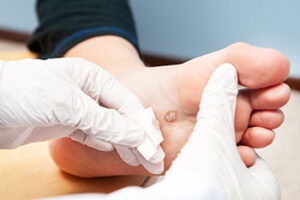Plantar warts are caused by the human papillomavirus (HPV) and vary in appearance and location on the sole. Note that different types of plantar warts exist, but the primary cause is the same: infection with the HPV virus. The specific appearance and location of the wart varies from person to person. Common plantar warts are the typical type of plantar wart. They appear as small, raised growths with a rough, grainy texture on the sole. The warts have black dots (clotted blood vessels) within them, giving them a speckled appearance. Regardless of the type, treatment options and prevention strategies remain consistent, focusing on eliminating the wart and reducing the risk of recurrence. If you suspect you have a plantar wart or an unusual growth on your foot, consult a podiatrist Houston at DeNiel Foot & Ankle Center, for proper diagnosis and guidance on the treatment approach.
Plantar wart removal is done through various methods, depending on the severity and location of the wart. After successful plantar wart removal, take preventive measures such as maintaining good foot hygiene, wearing protective footwear in public areas, and keeping your feet dry. Regardless of the Plantar wart treatmentmethod chosen, follow your podiatrist’s instructions and be patient, as plantar warts can take time to resolve. Avoid picking or removing plantar warts at home to prevent potential spread to other areas.
How to remove plantar warts:
- Over-the-counter (OTC) Treatments:Salicylic Acid: OTC treatments containing salicylic acid are in forms, such as gels, pads, and liquids. Theproducts work by gradually breaking down the wart tissue.
- Cryotherapy (Freezing):A foot doctor uses liquid nitrogen to freeze the plantar wart. Cryotherapy causes the wart to blister and eventually fall off. Multiple sessions are required.
- Prescription Medications:Afoot doctor prescribes medications, such as topical treatments or oral medications, to treat plantar warts.
- Electrosurgery or Laser Therapy:These are medical procedures using an electrical current or laser to burn or destroy the wart tissue. These methods are for stubborn or extensive warts.
- Surgical Removal:Surgical removal of a plantar wart is considered as a last resort when other treatments fail. During the procedure, a podiatrist will cut out the wart and use stitches to close the wound.
- Immunotherapy:In these cases, a healthcare provider stimulates the immune system to fight the wart by using injections of Candida antigen.
- Duct Tape Occlusion:Some patients have reported success with duct tape occlusion therapy. It involves covering the wart with duct tape for several days and then removing it, soaking the wart, and gently rubbing it with an emery board or pumice stone. Repeat the process until the wart is gone.
Warts thrive in warm, damp environments. Change your shoes and socks daily to help keep your feet dry.Additionally, the immune system can help your body fight the HPV virus. Eat a balanced diet, exercise regularly, get enough sleep, and manage stress to support your immune system.


No comments yet